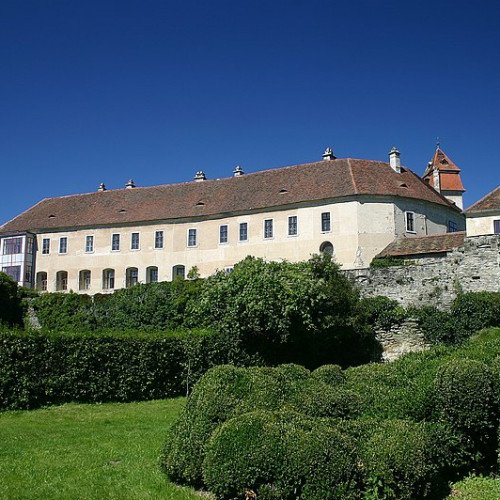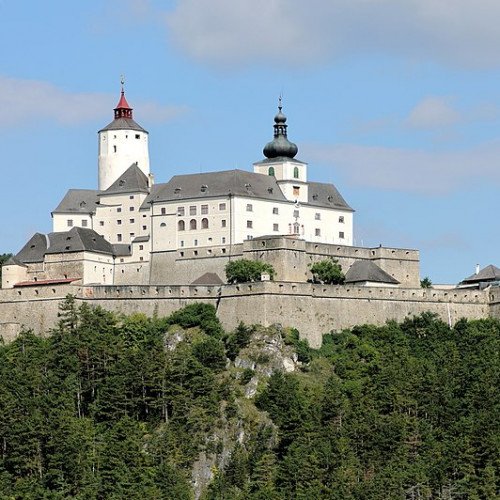Castles of "Austria" BERNSTEIN CASTLE vs FORCHTENSTEIN CASTLE

BERNSTEIN CASTLE
Bernstein Castle (Hungarian: Borostyánkő vára) is a historical building in Bernstein im Burgenland, Austria, first mentioned in the 13th century. In 860 the whole region was part of the archbishopric of Salzburg. Erimbert, a liege of the archbishopric, handed over the Pinka to one Jacobus. The village name Rettenbach was not mentioned yet, but the old Slavic name of the nearby hamlet Grodnau (meaning "the village belonging to the castle") is a sign of the existence of a nearby castle, identifiable with castle Bernstein. Bernstein Castle is 615 metres (2,018 ft) above sea level. Since 1199 the castle was part of Hungary. It is not exactly known when the castle was handed over to Frederick II, Duke of Austria, and how long it was his property; but in 1236 Béla IV of Hungary conquered the castle. Some years later (in 1260) he gave it to count Henry I Kőszegi. In 1336 the counts of Güssing and Bernstein were defeated by the Hungarian King Charles Robert of Anjou, and the castle of Bernstein became part of the Hungarian Kingdom. In 1388 the castle was given to the Kanizsai family. In 1482 it became property of Matthias Corvinus of Hungary for a short time; in 1487 Hans von Königsberg received the castle from Emperor Frederick III. In 1529 the Turks besieged the castle, but they were not able to capture it. Another unsuccessful siege by the Turks followed in 1532. On that occasion the ring of bastions was erected in order to change the castle into a refuge. In 1604 castle Bernstein was unsuccessfully besieged for weeks by a combined army consisting of Hungarians, Turks, and Tatars under the leadership of Stephen Bocskay. Due to an explosion of the gunpowder storeroom, in 1617 Ludwig Königsberg ordered the rebuilding of the Gothic inner part of the castle in Baroque style. The keep and towers were eliminated. A short time later (1644) Ehrenreich Christoph Königsberg sold the sovereignty and the castle to Count Ádám Batthyány. In 1864 Gustav Batthyány sold the castle to his manciple Edward O'Egan, whose heirs finally sold the castle to Eduard von Almásy. His family currently owns the castle. In 1953 a part of the castle was turned into a hotel and restaurant.
Statistics for this Xoptio

FORCHTENSTEIN CASTLE
Forchtenstein Castle (German: Burg Forchtenstein; Hungarian: Fraknó vára; Croatian: Fortnavski grad) is a castle built in the late Middle Ages near the municipality of Forchtenstein in northern Burgenland, Austria. Forchtenstein Castle is 511 metres (1,677 ft) above sea level. The first part of the castle with its 50-metre (160 ft) high keep was built in the beginning of the 15th century by the Lords of Mattersburg, who later named themselves Lords of Forchtenstein. The castle features a tower, known as the 'Black Tower' although the black rock that originally lined the tower has since been stripped. The tower contains a 12-metre (40 ft) deep pit used as a prison cell for those condemned to death. Rezallia, wife of Lettus of Forchtenstein used this with great frequency; on the return of her husband from military service, she was herself sentenced to death in the tower by her husband. Around 1450 the Lords of Forchtenstein died off due to lack of a male heir and the castle was passed over to the House of Habsburg, which owned it for 170 years. They leased it to others, including the Counts of Weissbriach and Hardegg. During this time the building was not changed significantly. In 1622 Nikolaus Esterházy, founder of the western Hungarian Esterházy line, received the castle from Emperor Ferdinand II, and Esterházy became a Count. Nikolaus started to fortify the crumbling castle and refurbished it with the services of Vienna builder Simon Retacco from 1630 to 1634 and with Domenico Carlone from 1643. The construction workers were all from Italy. This led to big orders for three masters of Kaisersteinbruch, the imperial quarry: Ambrosius Petruzzy, Pietro Maino Maderno, and Mathias Lorentisch. Kaiserstein stone was used for the main portals, fountains, cannonballs, etc. Once hewn the stone was delivered on large wagons drawn by six oxen. In the second half of the 17th century his son Paul further extended and ornamented the castle with architect Domenico Carlone. After Paul's death the castle's function changed. It became a repository for weapons, archives, chronometers, machines, exotic animal preparations and other "marvels". The only access to the treasure vault was a secret passage leading to a door requiring two different keys used together. One key was kept by the Count and the other by his treasurer. In the second half of the 18th century the castle was extended by master builder Ferdinand Mödlhammer. During this work the roof truss was lifted and the interior was renovated. The treasure vault remained undiscovered and intact throughout World War II. The original glass-paned cabinets containing the collection are works of art in themselves. The castle is still owned by the Esterházy family and, together with Schloss Esterházy in Eisenstadt, it chronicles the history and treasures of this ancient aristocratic family. When Austria and Hungary separated in 1921, the Esterházy family's lands were split between the two countries. Their financial records remained at Castle Forchtenstein and the family records were taken to the Hungarian Federal Archive in Budapest.